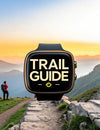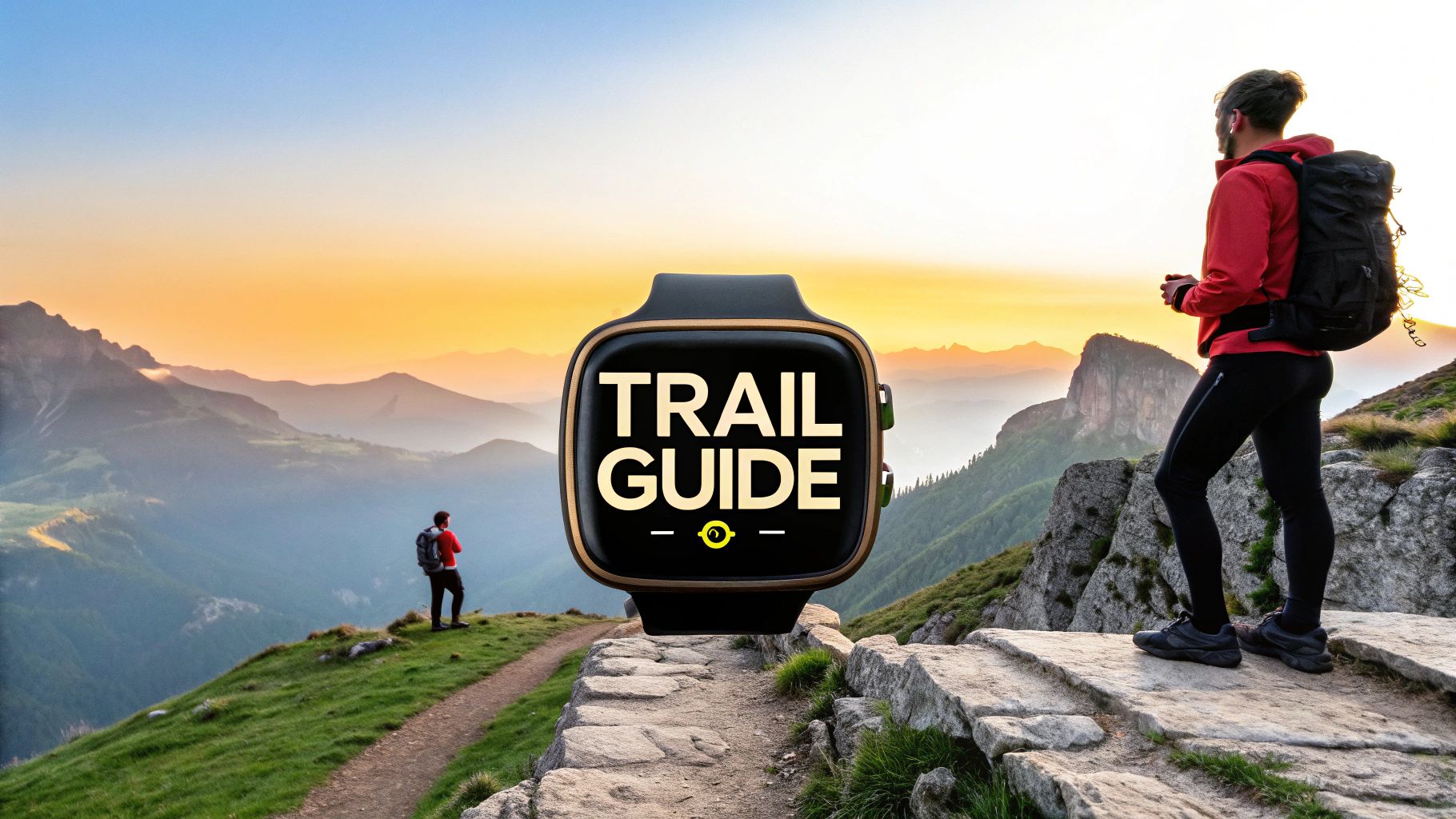
When you start looking for the best GPS watches for hiking, a few names always pop up: the Garmin Fenix series, the Coros Apex 2 Pro, and the Suunto 9 Peak Pro. These aren't just popular by chance; they consistently deliver the goods with solid navigation, battery life that lasts for days, and the kind of toughness you need for the trail. They're the go-to choices for a reason, built to be reliable partners for any backcountry trip.
How to Choose Your Perfect Hiking GPS Watch
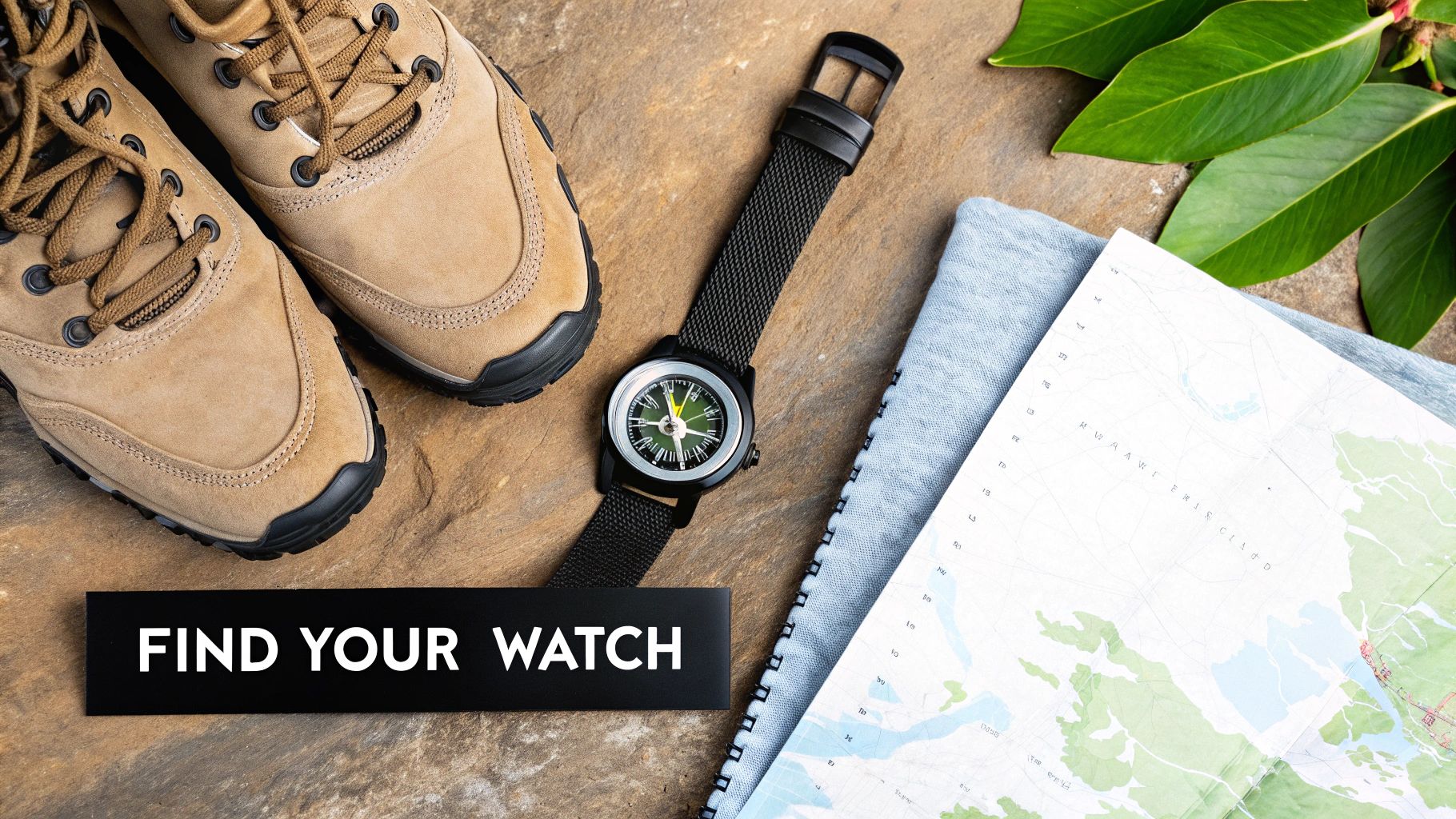
Trying to pick the right GPS watch can feel like you're staring at a wall of gear with a million different specs. It’s easy to get lost. So, let’s cut through the noise and focus on what actually matters out there: can it get you where you're going, will the battery die halfway through, can it take a beating, and does it track your body’s response to the effort? These are the pillars of a great hiking watch—the non-negotiables for staying safe and having a good time.
It's clear hikers are embracing this tech. The market for outdoor sports GPS smartwatches swelled to about $18 billion in 2023 and is expected to climb to $30 billion by 2028. That's a whole lot of people trusting their adventures to a device on their wrist. You can dig into the GPS watch market trends on marketreportanalytics.com if you're curious.
To give you a head start, here’s a quick look at our top picks. This table cuts right to the chase, highlighting the best all-arounder, the battery king, and the smartest choice if you're on a budget.
Quick Picks The Best GPS Hiking Watches at a Glance
This summary table highlights our top-rated GPS watches for hiking across key categories, giving you a fast overview before we dive into the details that make these watches tick.
| Category | Watch Model | Key Feature Highlight | Best For |
|---|---|---|---|
| Best Overall | Garmin Fenix 7 Pro | Best-in-class topographic maps, solar charging, and a built-in flashlight. | Hikers who want the most powerful and feature-rich navigation tool available. |
| Battery Champion | Coros Apex 2 Pro | Up to 75 hours of full GPS tracking and 30 days of regular use. | Thru-hikers, ultrarunners, and multi-day backpackers needing maximum endurance. |
| Top Value Pick | Coros Pace 3 | Lightweight design with dual-frequency GPS and solid battery life at a great price. | Budget-conscious hikers and trail runners who need reliable core features. |
This quick comparison should help you zero in on a watch that fits your hiking style. Now, let's get into the nitty-gritty of why these features are so important.
Think of a good hiking GPS watch as your lifeline. It’s not just another gadget. It’s your compass, map, weather station, and personal fitness coach, all rolled into one tough package on your wrist. Sure, your smartphone has maps, but a dedicated watch is built to withstand drops and downpours, and crucially, it works when you have zero bars of cell service. Out in the wild, that's a game-changer.
A dedicated GPS watch provides peace of mind. Its ability to track your route, guide you back to your starting point, and monitor vitals without relying on a fragile phone is what transforms it from a convenience into an essential piece of safety equipment.
Why Your Phone GPS Isn't Enough for the Trail
Thinking your smartphone can replace a dedicated GPS watch on the trail is a bit like taking a city sedan on a rugged 4x4 track. Sure, it might get you down a well-graded dirt road, but it’s just not built for the tough, unpredictable backcountry. While phone apps are great for a stroll in a city park or a local, well-marked trail, they have some serious weak spots that can become dangerous liabilities when you're miles from anywhere.
The most obvious problem is durability. Let's face it, your smartphone is a delicate piece of glass and circuitry. It's not designed to survive the bumps, scrapes, and hard drops that are part of any real hiking adventure. One clumsy slip on a rocky path could easily mean a shattered screen and a useless map, leaving you in a very tight spot.
On top of that, most phones aren't truly waterproof. A sudden downpour or an accidental dunk during a creek crossing can fry your primary navigation tool in an instant. A proper hiking GPS watch, however, is built like a tank—often to military-grade standards—and has water-resistance ratings that can handle a full submersion without a problem.
The Lifeline of Battery and Connectivity
Beyond just being tough, the real deal-breakers are battery life and signal reliability. We've all seen how fast a phone battery dies when you're running a GPS app. On a long day hike, let alone a multi-day trek, your phone's power will plummet, forcing you to choose between navigating and saving that last bit of juice for an emergency call.
That's a choice you never want to be forced to make. Hiking watches are engineered specifically for this job. Their batteries are built to last for dozens of hours in full GPS mode, and some can even go for weeks in lower-power expedition settings.
The most critical advantage of a GPS watch is that it doesn't need a cell signal to work. It pulls its location data directly from satellites, giving you a reliable position even when your phone is just a useless brick showing "No Service." This is an absolute lifesaver in remote canyons, dense forests, or high mountain passes where cell coverage is a fantasy.
Specialized Tools for Serious Navigation
A dedicated hiking watch is more than just a map on your wrist; it's a suite of specialized tools that phone apps just can't replicate. These features are all about keeping you safe and aware out on the trail.
- Breadcrumb Trails: The watch automatically records your path as you move, leaving a digital "breadcrumb trail." If you get turned around, you can simply follow this line back the way you came.
- Trackback Function: Many watches have a "TrackBack" or "Back to Start" feature that guides you back along your recorded route at the push of a button. No thinking required.
- ABC Sensors: This is huge. An Altimeter, Barometer, and Compass give you critical real-time information. The barometer, for example, can detect a sudden drop in air pressure, warning you of an approaching storm long before the sky looks threatening.
These aren't just fancy gadgets; they are proactive safety tools. A phone shows you a map. The best GPS watches for hiking give you a complete navigation and environmental monitoring system on your wrist. While knowing how to use a map and compass remains a non-negotiable skill, a good watch is the best modern backup you can have. It's a real investment in your safety and confidence out there.
Decoding the Tech That Keeps You on Track
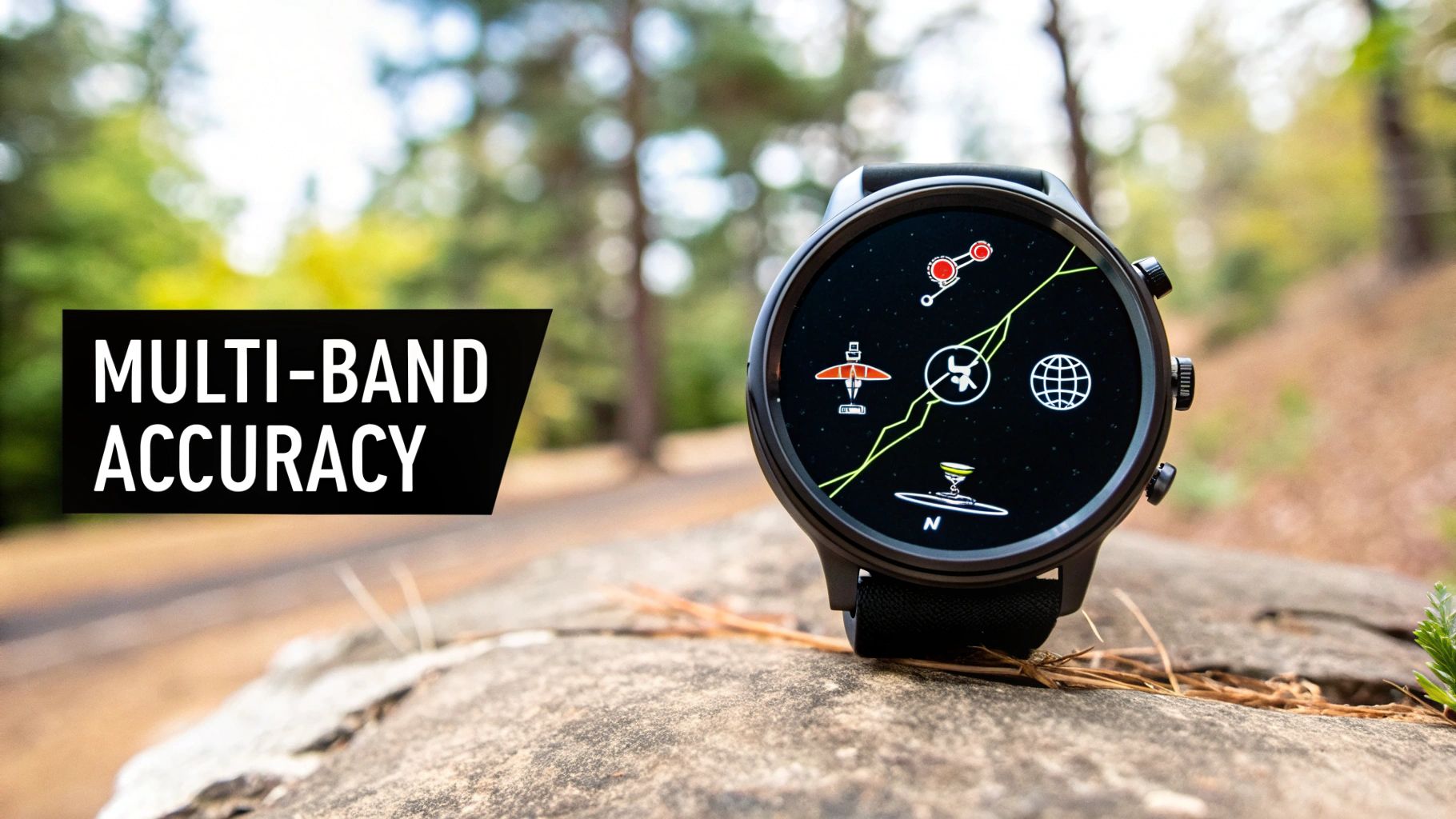
Let's pull back the curtain and get into what really makes a great hiking GPS watch tick. Forget the marketing jargon. When you understand the tech inside, you can look at a spec sheet and know exactly which features will actually help when you're miles from the trailhead. It’s all about practical tools that keep you safe and heading in the right direction.
This kind of tech is getting better and more common, which is why the market is booming. The outdoor GPS fitness watch market was valued at $15 billion in 2025 and is expected to climb to $45 billion by 2033. That growth is all thanks to powerful features like GPS, altimeters, and heart rate monitors being packed into smaller, more stylish devices. You can dive deeper into the numbers by checking out the full research on the outdoor fitness watch market.
Beyond Basic GPS: Multi-GNSS Explained
Think of satellite navigation like trying to tune into a radio station. If you can only listen to one station (the standard American GPS system), you might get a lot of static—or lose the signal completely—in a deep canyon or under a thick forest canopy. This is where Multi-GNSS comes in to save the day.
A watch with Multi-GNSS is like a radio that can tune into multiple stations at once. It's not just listening to GPS, but also other global systems like Russia's GLONASS or Europe's Galileo. By tapping into several satellite networks at the same time, your watch has a much better shot at locking onto a strong, accurate signal, no matter how much of the sky is blocked.
The best watches take it even further with multi-band (or dual-frequency) GPS. This feature lets the watch listen for multiple signals from the same satellite on different frequencies. It's a clever way to filter out errors caused by atmospheric weirdness or signals bouncing off canyon walls. The result? A location fix so precise you can truly depend on it.
Your Personal Weather Station: ABC Sensors
One of the most powerful toolsets you'll find in a dedicated hiking watch is the trio of ABC sensors: Altimeter, Barometer, and Compass. These aren't just for data geeks; they give you critical, real-time information about your immediate surroundings.
- Altimeter: This uses air pressure to figure out your elevation. It’s absolutely essential for knowing how much you've climbed and how much more you have to go on a big ascent.
- Barometer: By tracking changes in air pressure, the barometer becomes your personal weather forecaster. A sudden, sharp drop in pressure is a classic sign of an incoming storm, giving you a vital heads-up to find shelter.
- Compass: A 3-axis digital compass shows your bearing even when you're standing still—a huge advantage over GPS-based compasses that need you to be moving to figure out which way you're facing.
Together, these sensors paint a complete picture of your environment. They help you track your progress, anticipate weather changes, and stay oriented. It’s like having a full-blown situational awareness tool right on your wrist. For a refresher on the basics, our guide covers other essential navigation tools for hiking.
Maps and Planning That Work Offline
Seeing a dot on a blank screen is one thing, but having a detailed map right on your wrist is a total game-changer. The top hiking GPS watches come with preloaded topographic maps, which show you the actual shape of the land with contour lines, along with trails, rivers, and other landmarks.
The key here is that these maps are stored offline, right on the watch. That means you have full navigation capabilities even when you're miles away from the nearest cell signal. You can preserve your phone's battery for real emergencies and still see exactly where you are in relation to the terrain, making it easy to spot a water source or find a safe escape route if plans go sideways.
Many watches also include ascent planning features. These tools analyze your pre-loaded route and break down every climb, showing you the grade, distance, and total elevation gain for each upcoming segment. It’s an incredible way to pace yourself and make smarter decisions about when to push hard and when to take a breather. If you're curious about the complex engineering inside these devices, this Apple Watch Series 6 teardown offers a fascinating look at how they're built.
How Long Will It Last? A Realistic Look at Battery and Durability
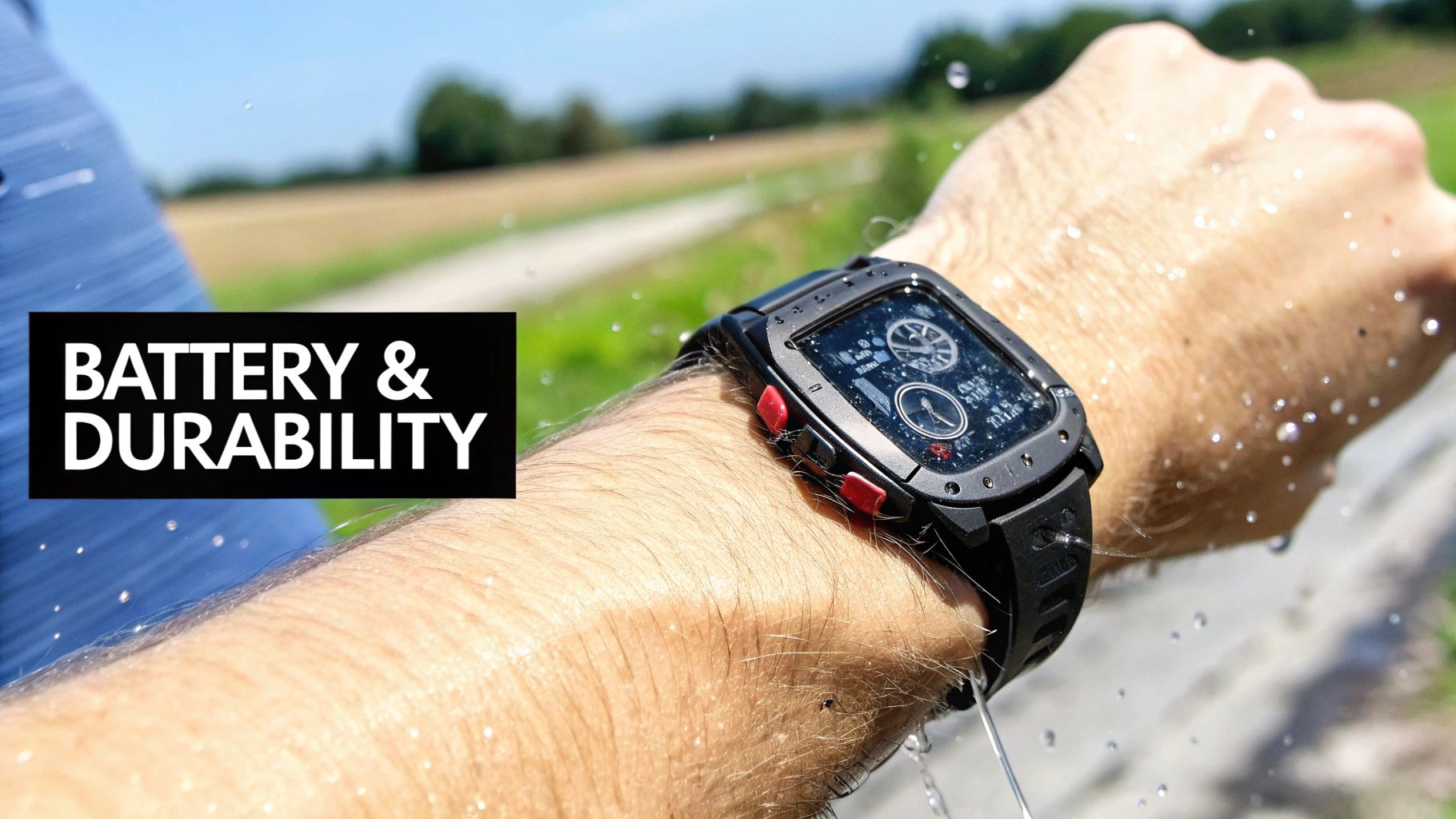
Out on the trail, miles from the nearest outlet, your watch is more than just a gadget—it's a lifeline. But if it dies, it's nothing more than a pricey bracelet. This is where two things matter above all else: battery life and durability. Let's cut through the marketing jargon and talk about what these mean in the real world, so you can pick a watch that won’t let you down when you need it most.
It’s no surprise that GPS watches have taken over the market, pushing handheld units to the side. Top brands like Garmin, Suunto, and Coros are in a constant race to pack more accuracy, health tracking, and safety features onto your wrist. The result is a generation of incredibly capable devices you can wear from the trail to the office.
Demystifying Battery Claims
Watch companies love to advertise battery life in weeks, but those impressive numbers rarely tell the whole story for a hiker. The truth is, how long your watch lasts depends entirely on what you're asking it to do. Knowing the different power modes is the key to understanding what you’ll actually get.
- Full GPS Mode: This is the big one. It's the most power-hungry setting where your watch is constantly talking to satellites for maximum accuracy. Expect anywhere from 20 to 75 hours on most models. This is the number you should care about for long day hikes and weekend trips.
- Expedition or Ultra Mode: Heading out for a few days? This mode is your best friend. It saves juice by checking your location less frequently—say, once a minute instead of every second. It’s the perfect compromise for multi-day treks where you need the battery to stretch for a week or more.
- Standard Smartwatch Mode: This is where those "weeks-long" claims come from. It assumes you're just using the watch for phone notifications and basic activity tracking, with the GPS turned off.
Lately, solar charging has become a legitimate game-changer. Watches with this tech have a transparent solar layer on the screen that constantly sips power from the sun. It can seriously extend your battery life in GPS mode and, in some cases, give you virtually unlimited power in a basic battery-saver mode.
Don't make the classic mistake of seeing "30-day battery life" on the box and thinking you're set for a week-long trek. Always dig into the specs and find the "Full GPS Mode" number—that's your real trail time.
Built for the Trail: Understanding Durability Standards
Your hiking watch is going to get beat up. It'll get scraped on rocks, dunked in streams, and exposed to freezing temps and blistering heat. How well it handles that abuse all comes down to its materials and construction.
A great seal of approval to look for is the MIL-STD-810 rating. This is a set of brutal tests designed by the U.S. military to ensure gear is combat-ready. If a watch has this certification, it means it has survived serious drops, shocks, and wild temperature swings. It’s solid peace of mind that a simple stumble won't be the end of your expensive device.
The materials used for the screen and body are just as crucial.
| Material | Key Advantage | Why It Matters for Hiking |
|---|---|---|
| Sapphire Crystal | Extreme scratch resistance | Shrugs off scrapes from rocks and branches, keeping your screen clear and readable. |
| Gorilla Glass | High impact resistance | More likely to survive a direct drop onto a rock without shattering. |
| Titanium | High strength-to-weight ratio | Gives you the toughness of steel at almost half the weight, so you barely feel it. |
| Fiber-Reinforced Polymer | Lightweight and durable | A tough, practical choice for the watch body that doesn't add a ton of bulk or cost. |
Choosing premium materials like sapphire and titanium is an investment in a watch that will survive years of adventures. If you’re really serious about toughness, you can find roundups of the toughest watches built specifically to handle the absolute worst conditions.
And for those multi-day trips where even the beefiest battery might be cutting it close, a little backup is smart planning. We've got a guide to the best portable chargers for travel that can help you find a lightweight power bank to toss in your pack.
Our Top GPS Watch Picks for Every Hiker
Alright, we’ve covered the tech, talked battery life, and stressed the importance of a tough build. Now for the fun part. Let's look at how the top watches actually perform out on the trail, where specs on a webpage meet the reality of a muddy, rain-soaked ascent.
I'm going to walk you through my top picks from the brands that dominate the outdoor space: Garmin, Coros, and Suunto. My focus here isn't just on listing features, but on what those features mean when you're miles from the nearest road and counting on your gear to get you home safely.
The Garmin Fenix 7 Pro: The Ultimate All-Rounder
If you're the kind of hiker who wants the absolute best of everything in one package, the Garmin Fenix 7 Pro is your watch. I like to think of it as the Swiss Army knife for your wrist—it has a dedicated tool for just about any situation you can imagine in the wild.
Its biggest selling point for hikers is, without a doubt, the preloaded topographic maps. They are incredibly detailed, fully routable (meaning the watch can create a route for you), and a dream to read on the bright, solar-charging display. Pair that with its multi-band GNSS, and you get a satellite lock that is unbelievably fast and accurate, even when you're deep in a canyon or under a thick canopy of trees.
For me, the ClimbPro feature is a total game-changer on mountain hikes, breaking down every climb into manageable segments with real-time data. And you’ll be surprised how often you use the built-in LED flashlight. It seems like a gimmick until you're trying to find something in your tent at 2 a.m. and your headlamp is buried in your pack.
The Garmin Fenix isn't just a watch; it's a complete backcountry navigation and safety system on your wrist. For hikers who demand the most powerful mapping and data tools, it remains the undisputed king of the trail.
The Coros Apex 2 Pro: The Battery Endurance Champion
For anyone planning a thru-hike or a multi-day backpacking trip, there’s one question that trumps all others: "Will my battery die?" The Coros Apex 2 Pro answers that question with a confident "not a chance."
This watch has built its entire reputation on mind-blowing battery life. We're talking up to 75 hours of continuous tracking in full GPS mode and a wild 30 days of regular smartwatch use. That means you can tackle a week-long trek through the Sierras without even thinking about packing a battery bank for your watch.
Now, its mapping isn't as advanced as Garmin's. You can load a route and follow a breadcrumb trail on a map layer, but you can't create new routes on the fly directly from the watch. Honestly, for most hikers, that's all you need. It gets the job done reliably, and its sapphire glass screen and titanium bezel give it a premium, durable feel without weighing you down.
I also have to give Coros credit for its dead-simple interface. When you're exhausted after a long day, you don't want to fight with complicated menus; you just want to find what you need quickly, and the Apex 2 Pro nails that.
The Suunto Vertical: The Rugged Explorer
Suunto has been making rock-solid compasses and outdoor instruments for decades, and the Suunto Vertical is a perfect example of that heritage. This thing is built like a tank—it's made in Finland and tested to military standards, so you know it can handle a beating.
Its standout feature is the free, downloadable offline topographic maps. They are beautifully detailed and fantastic for both planning at home and navigating when you have zero cell service.
The battery life is already impressive at a solid 60 hours of GPS tracking, but if you opt for the titanium solar model, that number gets even better. It’s a seriously reliable partner for those long, off-grid expeditions.
Suunto's design philosophy has always been about clean, functional simplicity. The Vertical gives you all the crucial hiking data—altitude, barometric pressure, compass—in a format that’s incredibly easy to read at a glance. It's the perfect watch for the hiker who values rugged reliability over having a million different features.
Hiking GPS Watch Feature Showdown
To make things even clearer, here’s a quick-glance table comparing our top picks. Think of it as a cheat sheet to match your personal hiking priorities—be it mapping, battery, or budget—with the right watch.
| Watch Model | Battery Life (GPS Mode) | Mapping Capability | Key Durability Feature | Price Range |
|---|---|---|---|---|
| Garmin Fenix 7 Pro | Up to 37 hours (with solar) | Full Topographic, Routable | MIL-STD-810, Power Sapphire | High |
| Coros Apex 2 Pro | Up to 75 hours | Breadcrumb on Map Layer | Sapphire Glass, Titanium Bezel | Mid-High |
| Suunto Vertical | Up to 60 hours (85 w/ solar) | Full Topographic, Offline | MIL-STD-810, Sapphire Glass | Mid-High |
| Coros Pace 3 | Up to 38 hours | Basic Breadcrumb Only | Gorilla Glass, Polymer Bezel | Low-Mid |
Ultimately, there's no single "best" watch, only the best watch for you. Whether you need the advanced mapping of a Fenix, the incredible endurance of an Apex 2 Pro, or the rugged simplicity of a Suunto Vertical, any of these will be a fantastic tool on the trail. It all comes down to your personal style of adventure.
How to Make Your Final Choice
Alright, let's pull all of this together. The final step is really about taking an honest look at your own hiking habits and matching them to the features we've covered. Finding the best GPS watch for hiking isn't about some single "perfect" device—it's about finding the perfect watch for you.
Think about it: are you mostly doing day hikes on well-marked local trails? Or are you a weekend warrior who disappears into the backcountry from Friday to Sunday? Maybe you're a serious mountaineer planning expeditions that last for weeks. Your answer changes everything.
Someone who sticks to day hikes can get by just fine with a simpler, more affordable watch. What matters most is solid GPS tracking and maybe some basic health stats. For weekend backpackers, the game changes. You need to start prioritizing battery life, especially in full GPS mode, to make sure your watch lasts the entire trip. For a 2-3 day adventure, breadcrumb navigation is usually more than enough.
Matching the Watch to Your Adventure
Now, if you're a serious mountaineer or a dedicated thru-hiker, you're in a different league entirely. You demand the absolute most from your gear. Features that are "nice to have" for others become non-negotiable for you.
You'll need things like multi-band GNSS for pinpoint accuracy in deep canyons, preloaded topographic maps for when the trail disappears, and a rugged build that can take a serious beating. Solar charging also stops being a cool gadget and becomes a mission-critical feature for staying powered up miles from the nearest outlet.
This handy infographic breaks down how your hiking style connects to things like budget, battery needs, and mapping features.
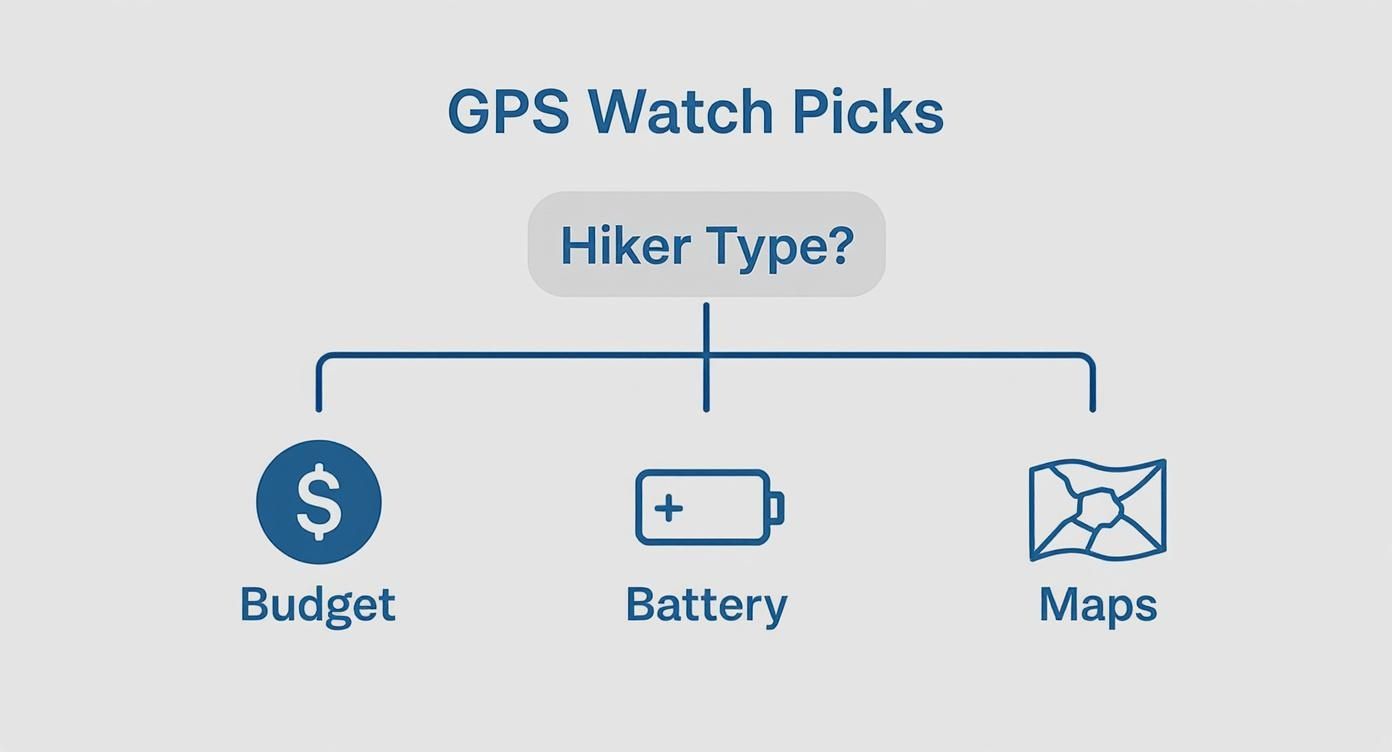
As you can see, there's a clear line from figuring out what kind of hiker you are to zeroing in on the features that will actually help you on the trail. If you're honest with yourself about how you hike, you can invest in a watch that’s not just another piece of tech, but a genuine tool you can rely on.
To help bring it all home, here’s a quick recap of our top picks:
- For the Data-Driven Explorer: The Garmin Fenix 7 Pro is still king when it comes to its incredible topographic maps and exhaustive feature set.
- For the Endurance Athlete: If multi-day battery life is your one true love, the Coros Apex 2 Pro is the undisputed champion.
- For the Rugged Minimalist: The Suunto Vertical delivers amazing durability and fantastic offline maps in a no-fuss, reliable package.
At the end of the day, you're choosing a companion for the trail. Pick the watch that gives you the confidence to explore safely and makes your time outdoors even better, knowing it won't let you down when you need it most.
Common Questions About Hiking GPS Watches
It's totally normal to have a few last-minute questions before you commit to a hiking watch. After all, it's a big investment. Let's tackle some of the most common ones I hear from hikers, so you can feel confident you're picking the right tool for your adventures.
These are the real-world questions you’ll likely ask yourself when you're staring at a wall of options, trying to decide what's a "must-have" versus a "nice-to-have."
Do I Really Need Offline Maps?
If you plan on hiking anywhere without a reliable cell signal, the answer is a firm yes. It's a non-negotiable feature for serious backcountry trips.
Basic GPS might show you as a blinking dot on a blank screen, but offline topographic maps give you the full picture. You can see the terrain's shape with contour lines, identify trails, and spot critical landmarks like streams or peaks. This is what lets you navigate with true confidence, especially if you need to find an alternate route or make smart decisions when you're completely off-grid. Plus, it means you can save your phone battery for true emergencies.
Think of it this way: a watch with offline maps isn't just a gadget, it's a completely self-reliant navigation tool on your wrist. It gives you the power to understand your environment and make changes on the fly without ever reaching for another device—a massive advantage in tricky weather or tough terrain.
Is Solar Charging Worth The Extra Cost?
This one really boils down to your hiking style. Are you a multi-day backpacker or a thru-hiker who will be away from civilization for long stretches? If so, solar charging is an absolute game-changer. It’s what keeps your watch going and gives you peace of mind on those epic adventures.
On the other hand, if you're mostly a day hiker or weekend warrior who gets home to a power outlet after every trip, it's probably overkill. The extra cost might not be justified. Think of solar as an insurance policy for serious off-grid endurance—a must for some, but a luxury for many.
Can I Use An Apple Watch For Serious Hiking?
An Apple Watch is a fantastic smartwatch for daily life and casual trails close to home, but it just doesn't cut it for serious backcountry use. The biggest issue is battery life; in GPS mode, you'll be lucky to get more than a few hours out of it.
They also aren't built with the same bombproof, weatherproof construction as dedicated hiking watches. More importantly, they often need your phone nearby to access full mapping features. The best GPS watches for hiking are designed from the ground up for one purpose: to survive the elements, run for days, and navigate on their own when you have zero signal.
Ready to find the perfect gear for your next adventure? At FindTopTrends, we curate the best outdoor and travel essentials to keep you safe and prepared on the trail. Explore our collections and get equipped for the wild at https://findtoptrends.com.






